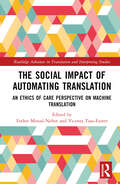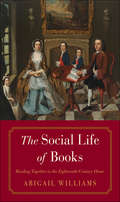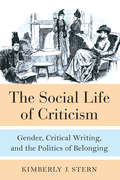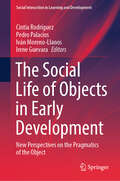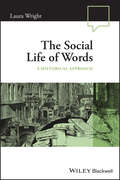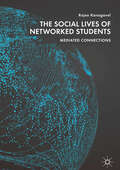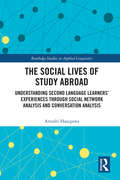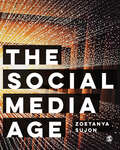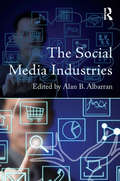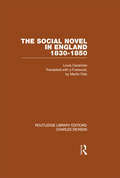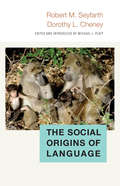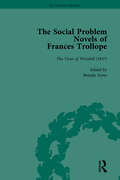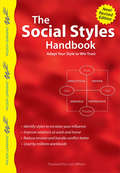- Table View
- List View
The Social Impact of Automating Translation: An Ethics of Care Perspective on Machine Translation (Routledge Advances in Translation and Interpreting Studies)
by Esther Monzó-Nebot and Vicenta Tasa-FusterThis collection critically examines the practical impacts of machine translation (MT) through the lens of an ethics of care. It addresses the ideological issues in MT development linked to social hierarchies and explores the transformative potential of care ethics for more equitable technological progress. The volume explores the ideological constructs behind MT as a labor-saving technology, how these constructs are embedded in both its development and social reception, and how they manifest in biased outputs. The chapters cover the cultural roots of translation automation, its legal and political implications, and the needs of various stakeholders. These stakeholders include lay users, Indigenous communities, institutions, educators, and professionals in an increasingly multicultural society. The book also addresses individuals who require translation daily with varying degrees of familiarity with their own translation needs and the tools available. Through critical engagement with the social impacts of MT, the book advocates for an epistemology of care to foster social equity and democratic values in technological progress. This book will interest scholars in translation studies, law, and sociotechnology, as well as practicing translators, policymakers, technologists, and activists seeking ethical and inclusive approaches to machine translation and technological development.
The Social Imperative
by Paula MoyaIn the context of the ongoing crisis in literary criticism, The Social Imperative reminds us that while literature will never by itself change the world, it remains a powerful tool and important actor in the ongoing struggle to imagine better ways to be human and free. Figuring the relationship between reader and text as a type of friendship, the book elaborates the social-psychological concept of schema to show that our multiple social contexts affect what we perceive and how we feel when we read. Championing and modeling a kind of close reading that attends to how literature reflects, promotes, and contests pervasive sociocultural ideas about race, ethnicity, gender, and sexuality, Paula M. L. Moya demonstrates the power of works of literature by writers such as Junot Diaz, Toni Morrison, and Helena Maria Viramontes to alter perceptions and reshape cultural imaginaries. Insofar as literary fiction is a unique form of engagement with weighty social problems, it matters not only which specific works of literature we read and teach, but also how we read them, and with whom. This is what constitutes the social imperative of literature.
The Social Institution of Discursive Norms: Historical, Naturalistic, and Pragmatic Perspectives (Routledge Studies in Contemporary Philosophy)
by Hans Bernhard Schmid Preston Stovall Leo TownsendThe essays in this collection explore the idea that discursive norms—the norms governing our thought and talk—are profoundly social. Not only do these norms govern and structure our social interactions, but they are sustained by a variety of social and institutional structures. The chapters are divided into three thematic sections. The first offers historical perspectives on discursive norms, including a chapter by Robert Brandom on the way Hegel transformed Kant’s normativist approach to representation by adding both a social and a historicist dimension to it. Section II features four chapters that examine the sociality of normativity from within a broadly naturalistic framework. The third and final section focuses on the social dimension of linguistic phenomena such as online speech acts, oppressive speech, and assertions. The Social Institution of Discursive Norms will be of interest to scholars and advanced students working in philosophy of language, philosophy of mind, and social philosophy.
The Social Life of Appalachian Englishes: A Sociolinguistic Introduction
by Allison Burkette Jennifer CramerAppalachian Englishes (AEs) possess an array of linguistic features that distinguish them from other American Englishes, yet the rich history of language in the United States has created a wealth of linguistic resources through factors such as immigration and contact, providing the environment for AEs to grow and adapt in ways that are also similar to other varieties of English. AEs have a long history of representation in linguistic literature, but until now no single work has examined the interplay of language production and perception with an eye toward the role that language plays in the construction of personal and social identities.The Social Life of Appalachian Englishes takes a sociolinguistic/sociocultural approach to exploring specific linguistic features highlighted in the Linguistic Atlas Projects and the social life of Appalachian varieties in terms of perceptions and use. Focusing on the single theme of the social life of language in Appalachia, the book aims to explore the implications of the kinds of variation found, reinforce the notion that social meaning and variation are inseparable, and illustrate how linguistic production and perception are interrelated. It uses new data to amplify this theme, presenting a novel combination of data from different sociolinguistic traditions (specifically, perceptual dialectology and traditional atlas-style dialectology). Opportunities for engagement are provided through QR codes linking to additional resources and discussion questions and exercises at the end of each chapter.This book is designed for students and researchers interested in general linguistics, sociolinguistics, American Englishes, language variation, linguistic anthropology, and Appalachian studies.
The Social Life of Books: Reading Together in the Eighteenth-Century Home (The Lewis Walpole Series in Eighteenth-Century Culture and History)
by Abigail Williams&“A lively survey…her research and insights make us conscious of how we, today, use books.&”—John Sutherland, The New York Times Book Review Two centuries before the advent of radio, television, and motion pictures, books were a cherished form of popular entertainment and an integral component of domestic social life. In this fascinating and vivid history, Abigail Williams explores the ways in which shared reading shaped the lives and literary culture of the eighteenth century, offering new perspectives on how books have been used by their readers, and the part they have played in middle-class homes and families. Drawing on marginalia, letters and diaries, library catalogues, elocution manuals, subscription lists, and more, Williams offers fresh and fascinating insights into reading, performance, and the history of middle-class home life. &“Williams&’s charming pageant of anecdotes…conjures a world strikingly different from our own but surprisingly similar in many ways, a time when reading was on the rise and whole worlds sprang up around it.&”—TheWashington Post
The Social Life of Criticism: Gender, Critical Writing, and the Politics of Belonging
by Kimberly J SternThe Social Life of Criticism explores the cultural representation of the female critic in Victorian Britain, focusing especially on how women writers imagined themselves--in literary essays, periodical reviews, and even works of fiction--as participants in complex networks of literary exchange. Kimberly Stern proposes that in response to the "male collectivity" prominently featured in critical writings, female critics adopted a social and sociological understanding of the profession, often reimagining the professional networks and communities they were so eager to join. This engaging study begins by looking at the eighteenth century, when critical writing started to assume the institutional and generic structures we associate with it today, and examines a series of case studies that illuminate how women writers engaged with the forms of intellectual sociability that defined nineteenth-century criticism--including critical dialogue, the club, the salon, and the publishing firm. In doing so, it clarifies the fascinating rhetorical and political debates surrounding the figure of the female critic and charts how women writers worked both within and against professional communities. Ultimately, Stern contends that gender was a formative influence on critical practice from the very beginning, presenting the history of criticism as a history of gender politics. While firmly grounded in literary studies, The Social Life of Criticism combines an attention to historical context with a deep investment in feminist scholarship, social theory, and print culture. The book promises to be of interest not only to professional academics and graduate students in nineteenth-century literature but also to scholars in a wide range of disciplines, including literature, intellectual history, cultural studies, gender theory, and sociology.
The Social Life of Objects in Early Development: New Perspectives on the Pragmatics of the Object (Social Interaction in Learning and Development)
by Cintia Rodríguez Pedro Palacios Iván Moreno-Llanos Irene GuevaraThis book fills a gap in early developmental psychology by providing a critical reconsideration of the status of artifact objects as protagonists of children's actions and communication. The main thesis explored in the book is that objects are part of the material culture; they have public functions and social meanings that are transmitted by the members of the community. Their meanings are not "naturally" given, and children are not born knowing what to do with objects. All chapters analyze and illustrate communication with parents, or with teachers and peers in the early-years school. The book also explores the status of action and uses of materiality in communicative situations with children on the autism spectrum. The book shows objects coming alive in action and in communication, shaping the social foundations and early development of the human psyche. The book is intended for use by scholars and researchers in developmental psychology, teachers in early childhood education (mainly 0-3 years), undergraduate and postgraduate students in the fields of psychology and education, and sociocultural psychologists interested in early development.
The Social Life of Words: A Historical Approach (Language in Society)
by Laura WrightA new approach to sociolinguistics, introducing the study of the social meaning of English words over time, and offering an engaging and entertaining demonstration of lexical sociolinguistic analysis The Social Life of Words: A Historical Approach explores the rise and fall of the social properties of words, charting ways in which they take on new social connotations. Written in an engaging narrative style, this entertaining text matches up sociolinguistic theory with social history and biography to discover which kind of people used what kind of word, where and when. Social factors such as class, age, race, region, gender, occupation, religion and criminality are discussed in British and American English. From familiar words such as popcorn, porridge, café, to less common words like burgoo, califont, etna, and phrases like kiss me quick, monkey parade, slap-bang shop, The Social Life of Words demonstrates some of the many ways a new word or phrase can develop social affiliations. Detailed yet accessible chapters cover key areas of historical sociolinguistics, including concepts such as social networks, communities of practice, indexicality and enregisterment, prototypes and stereotypes, polysemy, onomasiology, language regard, lexical appropriation, and more. The first book to take a focused look at lexis as a topic for sociolinguistic analysis, The Social Life of Words: Introduces sociolinguistic theories and shows how they can be applied to the lexicon Demonstrates how readers can apply sociolinguistic theory to their own analyses of words in English and other languages Provides an engaging and amusing new look at many familiar words, inviting students to explore the sociolinguistic properties of words over time for themselvesPart of Wiley Blackwell’s acclaimed Language in Society series, The Social Life of Words is essential reading for upper-level undergraduate students, graduate students, postdoctoral researchers, and linguists working in sociolinguistics, lexical semantics, English lexicology, and the history and development of modern English.
The Social Lives of Networked Students: Mediated Connections
by Rajee KanagavelThis book examines the social networks of international students, exploring the ways in which they experience social support and the role of the continuously evolving media landscape in their experiences of mobility. Drawing on survey data collected from over 250 respondents around the world, Rajee Kanagavel offers a social network analysis of transnational social formations to investigate the flow of social support through media channels, shedding light on how co-presence is no longer influenced by geographical distance. Kanagavel analyses the ways in which communication technologies are transforming the way we build and maintain relationships, and our ability to receive or give support across distance. As such, the book will be useful to scholars and students of sociology and media studies, particularly those with an interest in transnationalism, new media, social support and international student mobility.
The Social Lives of Poems in Nineteenth-Century America (Material Texts)
by Michael C. CohenPoetry occupied a complex position in the social life of nineteenth-century America. While some readers found in poems a resource for aesthetic pleasure and the enjoyment of linguistic complexity, many others turned to poems for spiritual and psychic wellbeing, adapted popular musical settings of poems to spread scandal and satire, or used poems as a medium for asserting personal and family memories as well as local and national affiliations. Poetry was not only read but memorized and quoted, rewritten and parodied, collected, anthologized, edited, and exchanged.Michael C. Cohen here explores the multiplicity of imaginative relationships forged between poems and those who made use of them from the post-Revolutionary era to the turn of the twentieth century. Organized along a careful genealogy of ballads in the Atlantic world, The Social Lives of Poems in Nineteenth-Century America demonstrates how the circulation of texts in songs, broadsides, letters, and newsprint as well as in books, anthologies, and critical essays enabled poetry to perform its many different tasks. Considering the media and modes of reading through which people encountered and made sense of poems, Cohen traces the lines of critical interpretations and tracks the emergence and disappearance of poetic genres in American literary culture. Examining well-known works by John Greenleaf Whittier and Walt Whitman as well as popular ballads, minstrel songs, and spirituals, Cohen shows how discourses on poetry served as sites for debates over history, literary culture, citizenship, and racial identity.
The Social Lives of Study Abroad: Understanding Second Language Learners' Experiences through Social Network Analysis and Conversation Analysis (Routledge Studies in Applied Linguistics)
by Atsushi HasegawaThis volume presents an innovative approach to understanding the language socialization process of second language learners in study abroad programs, focusing on the case of study abroad programs in Japan. Study abroad experiences are so diverse that both macro and micro viewpoints are needed to capture such complexity. This book looks for a way forward by adopting a novel approach which integrates social network analysis and conversation nalysis and allows for a fuller, more nuanced understanding of varying experiences of study abroad participants. Chapters draw on data from a wide range of sources, including participant observation, semi-structured interviews, social network surveys, and audio and visual recordings, to demonstrate the ways in which broader social forces, environmental factors, and individuals’ dispositions interact in myriad social contexts within the study abroad experience. Taken together, the volume offers readers a comprehensive portrait of social processes in study abroad programs and their implications for language development, making this key reading for students and scholars in second language acquisition, pragmatics, and applied linguistics.
The Social Media Age
by Zoetanya SujonExploring power and participation in a connected world. Social media are all around us. For many, they are the first things to look at upon waking and the last thing to do before sleeping. Integrated seamlessly into our private and public lives, they entertain, inform, connect (and sometimes disconnect) us. They’re more than just social though. In addition to our experiences as everyday users, understanding social media also means asking questions about our society, our culture and our economy. What we find is dense connections between platform infrastructures and our experience of the social, shaped by power, shifting patterns of participation, and a widening ideology of connection. This book introduces and examines the full scope of social media. From the social to the technological, from the everyday to platform industries, from the personal to the political. It brings together the key concepts, theories and research necessary for making sense of the meanings and consequences of social media, both hopefully and critically. Dr Zoetanya Sujon is a Senior Lecturer and Programme Director for Communications and Media at London College of Communication, University of the Arts London.
The Social Media Age
by Zoetanya SujonExploring power and participation in a connected world. Social media are all around us. For many, they are the first things to look at upon waking and the last thing to do before sleeping. Integrated seamlessly into our private and public lives, they entertain, inform, connect (and sometimes disconnect) us. They’re more than just social though. In addition to our experiences as everyday users, understanding social media also means asking questions about our society, our culture and our economy. What we find is dense connections between platform infrastructures and our experience of the social, shaped by power, shifting patterns of participation, and a widening ideology of connection. This book introduces and examines the full scope of social media. From the social to the technological, from the everyday to platform industries, from the personal to the political. It brings together the key concepts, theories and research necessary for making sense of the meanings and consequences of social media, both hopefully and critically. Dr Zoetanya Sujon is a Senior Lecturer and Programme Director for Communications and Media at London College of Communication, University of the Arts London.
The Social Media Industries (Media Management and Economics Series)
by Alan B. AlbarranThis volume examines how social media is evolving as an industry—it is an extension of traditional media industries, yet it is distinctly different in its nature and ability to build relationships among users. Examining social media in both descriptive and analytical ways, the chapters included herein present an overview of the social media industries, considering the history, development, and theoretical orientations used to understand social media. Covered are: Business models found among the social media industries and social media as a form of marketing. Social media as a form of entertainment content, both in terms of digital content, and as a tool in the production of news. Discussions of ethics and privacy as applied to the area of social media. An examination of audience uses of social media considering differences among Latinos, African-Americans, and people over the age of 35. Overall, the volume provides a timely and innovative look at the business aspects of social media, and it has much to offer scholars, researchers, and students in media and communication, as well as media practitioners.
The Social Media Journalist Handbook
by Yumi WilsonThe Social Media Journalist Handbook teaches readers how to be a real-world social media journalist, tracing the evolution of the field to its current-day practice. This book establishes social media journalism as the latest and one of the most effective ways to practice journalism in the 21st century. It features insights from top recruiters, editors, and senior producers working in the field, as well exercises that aid readers in developing the practical skills necessary to work successfully with social media. Readers will come away from the book with the knowledge to build strong social media strategies across different budgets, employing evergreen principles that work for different, ever-changing platforms. They’ll learn how to reach and engage with the maximum number of people, as well as find sources, raise one’s profile, conduct research, and produce stories. This book also features additional material online for instructors.
The Social Nature of Antibiotic Overprescription in China: Medical Conversations, Doctor–Patient Relationships, and Decision-Making (Routledge Studies in Language, Health and Culture)
by Nan Christine WangOffering a rarely seen glimpse into the realities of one of the biggest global public health crises in modern time, Wang’s book focuses on doctor–patient interactions in China to demonstrate the potential effects of health communication, doctor–patient relationship, and a matrix of social factors on overprescription of antibiotics.Based on a community-based survey, the book describes empirical findings regarding the high prevalence of non-prescribed antibiotics use for common colds among children in China. It covers the potential effects of overprescription on caregivers' attitudes and how physicians make prescribing decisions in medical consultations. Drawing from evidence in medical interaction data, readers are introduced to further empirical findings regarding the communicative behaviors that patient caregivers use to pressure for antibiotic prescriptions in real medical consultations. Following this, Wang reports findings regarding the communicative behaviors that physicians use to make treatment recommendations and caregivers use to launch treatment negotiations, leading to a discussion of the effect of the doctor–patient relationship on antibiotic overprescription. The book culminates in practice recommendations and provides teaching scenarios in which physicians successfully engage the caregivers into conversations to shape their expectations for antibiotic prescriptions in medical consultations.An important resource for scholars and students in health communication, linguistics, medical humanities, and medical sociology. Practitioners who are interested in understanding and improving clinical practices as well as policymakers aiming to combat antibiotic resistance will also find this book useful.
The Social Novel in England 1830-1850: Routledge Library Editions: Charles Dickens Volume 2 (Routledge Library Editions: Charles Dickens #Vol. 2)
by Louis CazamianThis is the first English translation of Le Roman social en Angleterre by Louis Cazamian, which is widely recognized as the classic survey of Victorian social fiction. Starting from the eighteenth century, Cazamian traces the ways in which rationalism and romanticism intertwined and competed, particularly in relation to radical political philosophy. He shows how industrialization polarized England, setting the industrial bourgeoisie in the van of progress in the first decades of the nineteenth century, until their political and economic triumph stirred up a passionate reaction against them. This reaction propelled novelists such as Charles Dickens who lies at the centre of his discussion. For this translation Martin Fido has provided a substantial foreword, and has revised and completed the bibliographical references and corrected the footnotes to assist the present-day reader.
The Social Origins of Language
by Robert M. Seyfarth Dorothy L. Cheney Michael L. PlattHow human language evolved from the need for social communicationThe origins of human language remain hotly debated. Despite growing appreciation of cognitive and neural continuity between humans and other animals, an evolutionary account of human language—in its modern form—remains as elusive as ever. The Social Origins of Language provides a novel perspective on this question and charts a new path toward its resolution.In the lead essay, Robert Seyfarth and Dorothy Cheney draw on their decades-long pioneering research on monkeys and baboons in the wild to show how primates use vocalizations to modulate social dynamics. They argue that key elements of human language emerged from the need to decipher and encode complex social interactions. In other words, social communication is the biological foundation upon which evolution built more complex language.Seyfarth and Cheney’s argument serves as a jumping-off point for responses by John McWhorter, Ljiljana Progovac, Jennifer E. Arnold, Benjamin Wilson, Christopher I. Petkov and Peter Godfrey-Smith, each of whom draw on their respective expertise in linguistics, neuroscience, philosophy, and psychology. Michael Platt provides an introduction, Seyfarth and Cheney a concluding essay. Ultimately, The Social Origins of Language offers thought-provoking viewpoints on how human language evolved.
The Social Problem Novels of Frances Trollope Vol 1
by Brenda Ayres Douglas Murray Priti Joshi Ann-Barbara Graff Christine SutphinFrances Milton Trollope (1779-1863) was a prolific, provocative and hugely successful novelist. She greatly influenced the generation of Victorian novelists who came after her such as Charles Dickens, George Eliot and Elizabeth Gaskell. This book features Trollope's social problem novels.
The Social Problem Novels of Frances Trollope Vol 2
by Brenda Ayres Douglas Murray Priti Joshi Ann-Barbara Graff Christine SutphinFrances Milton Trollope (1779-1863) was a prolific, provocative and hugely successful novelist. She greatly influenced the generation of Victorian novelists who came after her such as Charles Dickens, George Eliot and Elizabeth Gaskell. This book features Trollope's social problem novels.
The Social Problem Novels of Frances Trollope Vol 3
by Brenda Ayres Douglas Murray Priti Joshi Ann-Barbara Graff Christine SutphinFrances Milton Trollope (1779-1863) was a prolific, provocative and hugely successful novelist. She greatly influenced the generation of Victorian novelists who came after her such as Charles Dickens, George Eliot and Elizabeth Gaskell. This book features Trollope's social problem novels.
The Social Problem Novels of Frances Trollope Vol 4
by Brenda Ayres Douglas Murray Priti Joshi Ann-Barbara Graff Christine SutphinFrances Milton Trollope (1779-1863) was a prolific, provocative and hugely successful novelist. She greatly influenced the generation of Victorian novelists who came after her such as Charles Dickens, George Eliot and Elizabeth Gaskell. This book features Trollope's social problem novels.
The Social Psychology of English as a Global Language
by Robert M. MckenzieThis ground-breaking work is a detailed account of an innovative and in-depth study of the attitudes of in excess of 500 Japanese learners towards a number of standard and non-standard as well as native and non-native varieties of English speech. The research conducted refines the investigation of learner attitudes by employing a range of pioneering techniques of attitude measurement. These methods are largely incorporated from the strong traditions that exist in the fields of social psychology and second language acquisition and utilize both direct and indirect techniques of attitude measurement. The author locates the findings in the context of the wealth of literature on native speaker evaluations of languages and language varieties. The study is unique in that the results provide clear evidence of both attitude change and high levels of linguistic awareness among the informants of social and geographical diversity within the English language. These findings are analyzed in detail in relation to the global spread of English as well as in terms of the pedagogical implications for the choice of linguistic model employed in English language classrooms both inside and outside Japan. The issues examined are of particular interest to educators, researchers and students in the fields of applied linguistics, TESOL, second language acquisition, social psychology of language and sociolinguistics. The pedagogical and language policy implications of the findings obtained make essential reading for those with a specific focus on the role of the English language and English language teaching, both in Japan and beyond.
The Social Styles Handbook, Revised Edition
by Wilson Learning LibraryMore than two million people use Social Styles and Versatility skills to improve communication and relationships. Learn which Social Style you naturally prefer, how to read others' styles, and then adapt to them so you can build trust and influence more quickly. Proven, powerful life-changing tools for immediate impact at work and home.
The Social Work of Narrative: Human Rights and the Cultural Imaginary (Studies in World Literature #4)
by Gareth Griffiths Philip MeadThis book addresses the ways in which a range of representational forms have influenced and helped implement the project of human rights across the world, and seeks to show how public discourses on law and politics grow out of and are influenced by the imaginative representations of human rights. It draws on a multi-disciplinary approach, using historical, literary, anthropological, visual arts, and media studies methods and readings, and covers a wider range of geographic areas than has previously been attempted. A series of specifically-commissioned essays by leading scholars in the field and by emerging young academics show how a multidisciplinary approach can illuminate this central concern.
